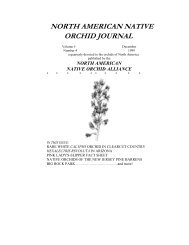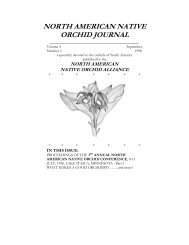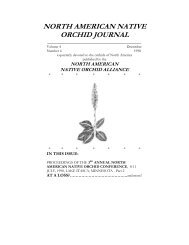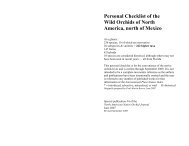north american native orchid journal - at The Culture Sheet
north american native orchid journal - at The Culture Sheet
north american native orchid journal - at The Culture Sheet
Create successful ePaper yourself
Turn your PDF publications into a flip-book with our unique Google optimized e-Paper software.
alba<br />
Brown & Folsom: WILD ORCHIDS OF THE WHITE MOUNTAINS OF NEW HAMPSHIRE AND MAINE<br />
EPIPACTIS is a cosmopolitan genus of about 25 species, only one of which, E. gigantea,<br />
is <strong>n<strong>at</strong>ive</strong> in North America, well west of the Southeast. Three Eurasian species<br />
can also be found in North America, including E. helleborine.<br />
Epipactis helleborine (Linnaeus) Cranz<br />
broad-leaved helleborine<br />
forma alba (Webster) Boivin–white-flowered form<br />
forma viridens A. Gray–green-flowered form<br />
Range: eastern North America; southeastern California; sc<strong>at</strong>tered in<br />
western North America; Europe<br />
In the White Mountains region: becoming locally common<br />
Plant: terrestrial, 10-80 cm tall<br />
Leaves: 3-7; altern<strong>at</strong>e, spreading; lance-elliptic, 2.5-4.0 cm wide × 10-18 cm<br />
long<br />
Flowers: 15-50; highly variable in color but normally yellowgreen<br />
usually suffused with rosy-pink, individual flowers 1-<br />
3 cm across<br />
Habit<strong>at</strong>: highly variable, from shaded calcareous woodlands<br />
to front lawns and garden beds and even the crack in a concrete<br />
sidewalk!; typically a lime-lover<br />
Flowering period: July to early September<br />
<strong>The</strong> widespread European Epipactis helleborine was first found in North America near<br />
Syracuse, New York in 1878. In the ensuing century-plus it has spread throughout the region<br />
and can now be found all the way eastward to downtown Boston, Massachusetts and<br />
<strong>north</strong>ward to Nova Scotia and Newfoundland, and in recent years westward to California.<br />
Plants appear to pop up here and there, usually in the vicinity of calcareous soils or debris. It<br />
can be equally happy in woodland and exposed situ<strong>at</strong>ions. With the exception of forma<br />
viridens, the various forms are exceedingly rare and are represented by very few collections.<br />
Exploring in a similar habit<strong>at</strong>, but a new area, yielded a<br />
rich abundance of the Epipactis th<strong>at</strong> likes to grow in limy<br />
areas like the old kiln site across the trail where the<br />
original site was discovered.<br />
forma viridens<br />
219













